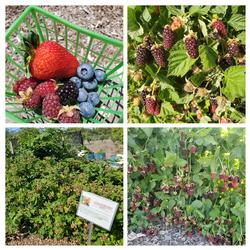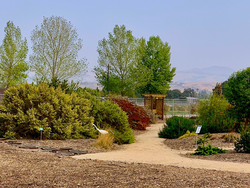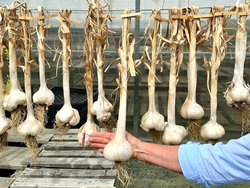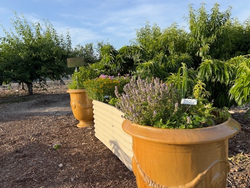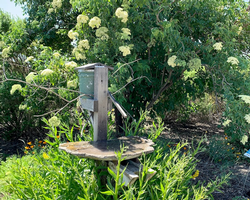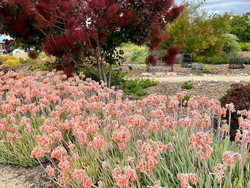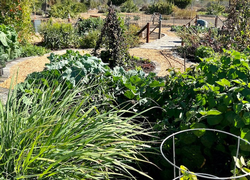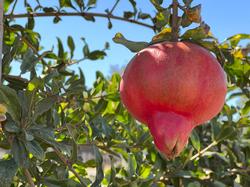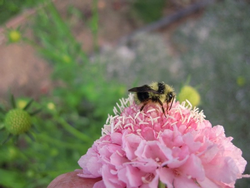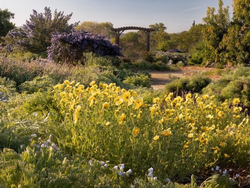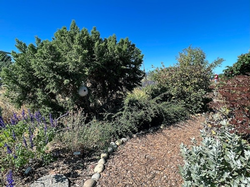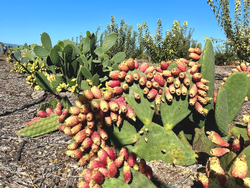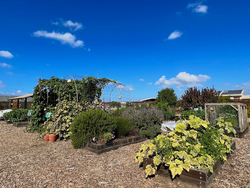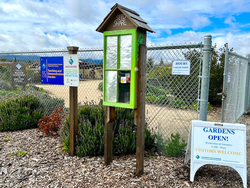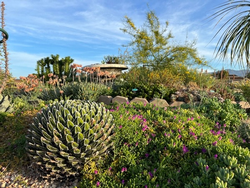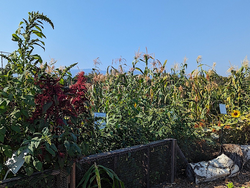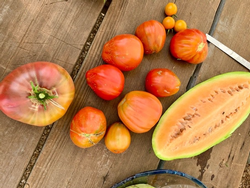Garden Collections
Our gardens at Martial Cottle Park are divided into many different collections with different themes and focuses. See descriptions below for details. Click the map to see a larger version with the collections labeled.
Important: Please respect our gardens and do not pick or eat any parts of the plants without permission.
Berry Patch
The Berry Patch demonstration area is located within the Orchard demonstration area and showcases a variety of berries and related fruits: grapes, blueberries, cane berries (blackberries, raspberries, etc.) and more. They are grown both in containers and in ground to demonstrate a range of planting options, along with educational information on each variety. The first berry plants were planted in fall 2021 through spring 2022 and have put on dazzling displays of growth and fruit since.
California Native Garden
Explore a wide array of California native plants suitable for home gardens. This area near the entrance and along the north fence displays low-water plants that provide habitat and food for local wildlife. Discover the year-round beauty of flowers, shrubs, and trees that are adapted to the California environment.
Experimental Beds
Nearly 50 experimental garden beds are used to grow and display trial projects to share research-based information with visitors. Observe ongoing trials of various fruits, herbs, and vegetables, such as garlic, peppers, strawberries, and melons. In winter, some beds are left fallow or cover crops are planted to rejuvenate the soil.
Garden to Glass
Nestled in the heart of the orchard is a ring of raised garden beds and planters containing over 50 plant varieties that can be used to create refreshing homemade beverages. Explore 'drink what you grow' ideas using roots, fruits, and shoots, aromatic herbs, and flowers for delicious herbal infusions, smoothies, garnishes, and more. Learn techniques for growing plants in small spaces while conserving water.
Habitat Haven
This exhibit along the east fence features plants selected to provide food and shelter for birds and pollinators in a balanced ecosystem. Salvias, ceanothus, buckwheats (Eriogonum spp.), and milkweeds (Asclepias spp.) are among the plants that flower from spring through summer. Trickling water provides necessary water for wildlife.
Mediterranean Climate Garden
The San Francisco Bay Area is one of a handful of regions with a Mediterranean climate: warm, dry summers and cool, wet winters. This garden features plants from other Mediterranean climate zone areas such as Chile, South Africa, Australia, and the Mediterranean basin. The mounding drifts of color are attractive all year long, and especially when plants such as ‘Long John’ Grevillea and Towers of Jewels (Echium wildpretii) are in bloom.
One World Kitchen Garden
Inspired by global cuisine, these three interconnected beds are dedicated to annual and perennial edibles that thrive in our climate. Discover nostalgic flavors from home as well as new-to-you crops, from rue to rhubarb and epazote to chrysanthemum greens.
Orchard
This 1-acre orchard features over 150 fruit varieties that can be grown in home gardens. Visitors are welcome to stroll through the wagon wheel layout of 110+ trees. The trees in the inner circle are planted to fruit one after the other in a clockwise direction. The outer ring is made up of themed sections: Backyard Land, Heritage Land, Weird Land, Orphan Land, Graft Land, Apple Land, Citrus Land, and Berry Land. Talks and workshops provide hands-on education in orchard planning and care.
Ornamentals
Sixteen in-ground beds host a vibrant display of annual and perennial flowers, providing inspiration for home gardens. The plentiful blooms attract a wide variety of bees, butterflies, and more. Materials from these beds are also used to create flower arrangements for summer workshops.
Pollinator Hill
Located near the entrance, this hill showcases a variety of flowering shrubs, perennials, bulbs, and annual wildflowers. Complementary purple and yellow blooms of buckwheat, ceanothus, phacelia, nemophila, and California poppies create a colorful expanse in early spring. Specimen trees, bee nesting boxes, and patches of exposed soil provide habitat for pollinators and other wildlife.
Pollinator Pathway Garden
This garden runs along the south fence and is dotted with self-guided educational signs. Follow a pathway through native wildflowers, insect hotels, water features, bee baths, and bluebird houses. It is the foundation for our ‘Mornings at Martial Cottle Park’ program which hosts educational field trips for kindergarten to 4th graders.
Prickly Pear Collection
This collection of over 20 prickly pear cacti with their distinctive paddle-shaped pads forms a border along the south fence. Native to the Americas, these easy-to-grow plants thrive in our hottest summers and coldest winters. Colorful flowers lead to the production of edible fruits called tunas.
School Beds
These eight beds are used for school field trips. Seasonal herbs and vegetables are grown to demonstrate square foot gardening, promote eating a rainbow of colors for a healthy diet, and provide a sensory experience. Depending on the season, visitors may see intriguing gourds, luffa vines, or artichokes.
Seed Share
Outside the Main Gate is the vibrant green Seed Share cabinet. Visitors are invited to take seeds to grow, then save and return fresh seeds for future gardeners. Be sure donated seeds are fully dried and clearly labeled. Partial seed packets are welcome too. Learn more about how and why to save seeds.
Succulent Garden
A beautiful array of succulents are clustered around a repurposed fountain near the Memorial Garden. A blue-green palo verde tree with bright yellow spring flowers anchors this garden. To expand your own succulent collection, come to one of our regular succulent sales, held on the third Saturday of every month.
Three Sisters & Sunflowers
Corn, beans, and squash are the "three sisters" planted in this plot, an example of companion planting. Corn provides tall stalks for the beans to climb. Beans fix nitrogen from the air to enrich the soil. Large squash leaves help shade out weeds and retain moisture. Cheerful sunflowers and colorful amaranth are planted in rotation every other year. In winter, cover crops are planted to improve the soil.








